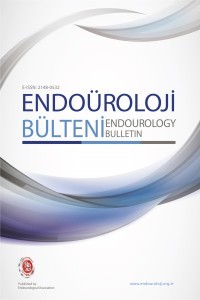Genç hastada mesane tümörü ve genetik alt yapı
Özet: Mesane kanseri her yaşta görülebilmekle beraber genç hastalarda nadir olarak görülmektedir. Sıklıkla ağrısız, pıhtılı hematüri şikayeti ile başvururlar. Literatürde genç hasta grubu olarak net yaşlar belirtilmemiştir ancak yayınlarda genel olarak ayrım 20 yaş altı,20-40 yaş arası ve 40 yaş üstü olarak alınmıştır. Kromozom 9 üzerinde bulunan ve mesane tümörü ile üzerinde durulan önemli yolaklardan bir tanesi PI3K yolağı ve buna bağlı PIK3CA dır(1). Mesane kanseri üzerindeki etkisi net olarak bilinmeyen PIK3CA gen mutasyonu olan genç hastayı sunduk. 22 yaşında erkek hasta hematüri şikayeti ile başvurdu. Ultrasonografide mesane sol yan duvar tabana yakın bölgede 6x4 cm papiller kitle saptandı. Transüretral rezeksiyon uygulandı ve histopatolojik inceleme sonucunda WHO/ISUP 2004 sınıflamasına göre yüzeyel, Düşük dereceli papiller ürotelyal karsinoma. (pTa, düşük grade) tanısı konuldu. Bu vakamızda saptadığımız PIK3CA gen mutasyonunun mesane kanseri olanlar ile ilişkisi olabilir. Literaturde PIK3CA gen mutasyonu ile mesane tümörü arasındaki bağlantı tam olarak aydınlatılmamıştır
Anahtar Kelimeler:
genç hasta, genetik alt yapı, mesane tümörü
Bladder cancer and genetic backround in young patients
Abstract. Although bladder cancer can be seen at any age, it is rarely seen in young patients. Patients often present with the complaint of painless clotted hematuria. Although there is no exact age range for young patients in the literature, published papers have defined classifications as under 20 years old, between 20 and 40 years old and over 40 years old. The PI3K pathway and the associated PIK3CA gene are located on chromosome 9 (1). In this case report, we aimed to present a young patient with PIK3CA gene mutation that has unclear effects on bladder cancer. A 22-year-old male patient applied to center. Ultrasonography showed a 6x4 cm papillary mass near the base of the left lateral wall of the bladder. Subsequently, transurethral resection was performed. Histopathological examination established the diagnosis of superficial low-grade papillary urothelial carcinoma (pTa Low-Grade) based on the WHO/ISUP 2004 classification. It was concluded that the PIK3CA gene mutation in this case may be related to bladder cancer.
Keywords:
bladder cancer, genetic background, young patıents,
___
- 1. Richards S, Aziz N, Bale S, et al. Standards and guidelines for the interpretation of sequence variants: a joint consensus recommendation of the American College of Medical Genetics and Genomics and the Association for Molecular Pathology. Genet Med 2015;17:405-24. doi: 10.1038/gim.2015.30.
- 2. Jemal A, Bray F, Center MM, Ferlay J, et al. Global cancer statistics. CA Cancer J Clin 2011;61:69-90.
- 3. Humphery PA, Moch H, Reuter VE, Ulbright TM.International Agency for Research on Cancer; World Health Organization. WHO Classification of Tumors of the Urinary System and Male Genital Organs, 4th ed.;International Agency for Research on Cancer: Lyon,France,2016
- 4. Antoni S, Ferlay J, Soerjomataram I, Znaor A, et al. Bladder Cancer incidence and mortality: A global overwiew and recent trends. Eur. Urol. 2017;71:96-108.
- 5. Stanton ML, Xiao L, Czerniak BA, Guo CC. Urothelial tumors of the urinary bladder in young patients: A clinicopathologic Study of 59 cases. Arch. Pathol. Lab. Med. 2013;137:1337-1341.
- 6. Sabah-Ozcan S, Baser A, Olcucu, et al. Human TLR gene family members are differentially expressed in patients with urothelial carcinoma of the bladder. In Urologic Oncology: Seminars and Original Investigations 2017;35:674-e11.
- 7. Dueñas M, Martínez‐Fernández M, García‐Escudero, R et al. PIK3CA gene alterations in bladder cancer are frequent and associate with reduced recurrence in non‐muscle invasive tumors. Mol. Carcinog. 2015;54:566-576.
- 8. Baffa R, Letko J, McClung C, et al. Molecular genetics of bladder cancer: targets for diagnosis and therapy. J Exp Clin Cancer Res 2006;25:145-160.
- 9. Betina SK, Katia RML. PIK3CA Mutations in Bladder Cancer: A Brief Review. Rev UN Med 2012;1:79-84.
- 10. Margaret AK, Fiona MP, Rebecca LR, et al. PI3K pathway activation in bladder cancer. Cancer Metastasis Rev 2009;28:w305-316.
- 11. Den Dunnen JT, Dalgleish R, Maglott DR, et al. HGVS Recommendations for the Description of Sequence Variants: 2016 Update. Hum Mutat 2016;37: 564-9. doi: 10.1002/humu.22981.
- 12. Landrum MJ, Lee JM, Benson M, et al. ClinVar: improving access to variant interpretations and supporting evidence. Nucleic Acids Res 2018;46:D1062-d7. doi: 10.1093/nar/gkx1153.
- Yayın Aralığı: Yılda 3 Sayı
- Başlangıç: 2020
- Yayıncı: ENDOÜROLOJİ DERNEĞİ
Sayıdaki Diğer Makaleler
Genç hastada mesane tümörü ve genetik alt yapı
Doğukan SÖKMEN, Yusuf İlker ÇÖMEZ, Volkan TUĞCU
Endoskopik üriner sistem taş tedavisi sonrası ürosepsis: riski artıran faktörler
Dilek BULUT, Merve Sefa SAYAR, Ender Cem BULUT, Alper BİTKİN, Fatih BIÇAKLIOĞLU, Serhat ÇETİN, Murat KOPARAL, Kasım ERTAŞ
Mini perkütan nefrolitotomi:yeni sistemlerin pratiğimize katkıları
Yusuf İlker ÇÖMEZ, Doğukan SÖKMEN
Üst üriner sistem taşları tedavisinde retrograd intrarenal cerrahi deneyimlerimiz
